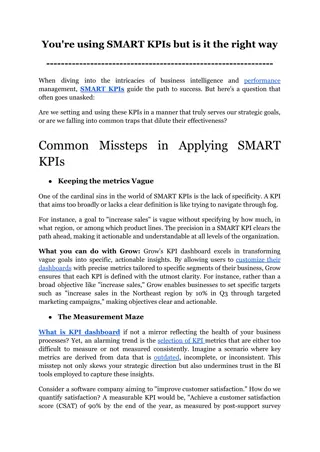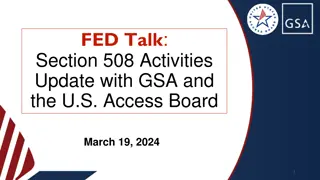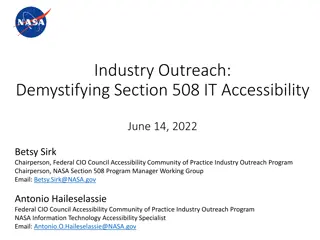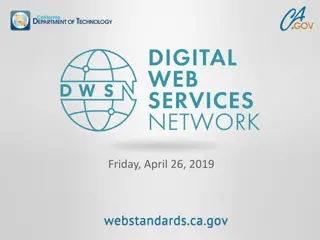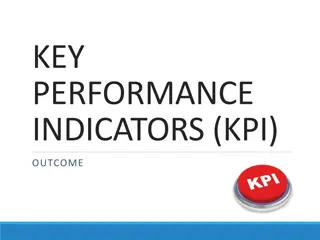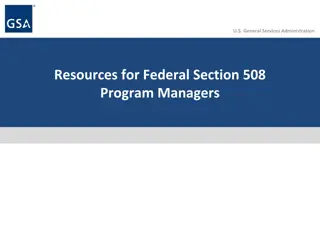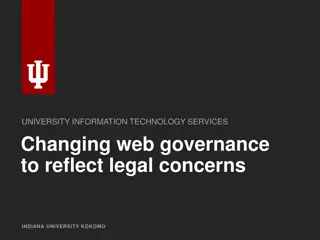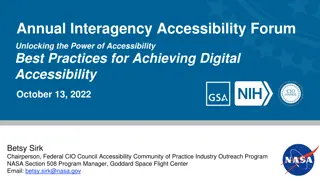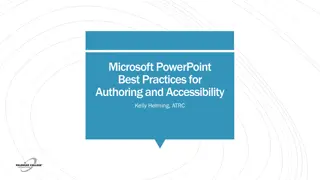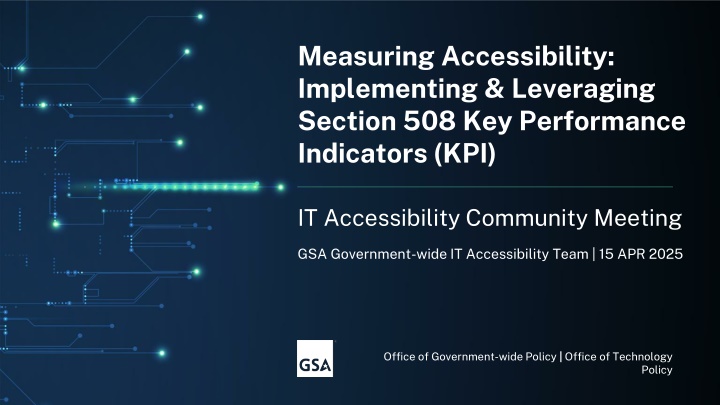
Leveraging Section 508 KPIs for IT Accessibility Success
Learn how to measure, implement, and leverage Section 508 Key Performance Indicators (KPIs) for IT accessibility success. This includes understanding strategic plans, KPI implementation, and the importance of accessibility in achieving compliance, accountability, and enhanced user experience.
Download Presentation

Please find below an Image/Link to download the presentation.
The content on the website is provided AS IS for your information and personal use only. It may not be sold, licensed, or shared on other websites without obtaining consent from the author. If you encounter any issues during the download, it is possible that the publisher has removed the file from their server.
You are allowed to download the files provided on this website for personal or commercial use, subject to the condition that they are used lawfully. All files are the property of their respective owners.
The content on the website is provided AS IS for your information and personal use only. It may not be sold, licensed, or shared on other websites without obtaining consent from the author.
E N D
Presentation Transcript
Measuring Accessibility: Implementing & Leveraging Section 508 Key Performance Indicators (KPI) IT Accessibility Community Meeting GSA Government-wide IT Accessibility Team | 15 APR 2025 Office of Government-wide Policy | Office of Technology Policy
OGP | Office of Technology Policy Introduction & Objectives Overview of Strategic Plans Elements of a Strategic Plan Understanding Key Performance Indicators (KPI) Understanding IT Accessibility KPIs Implementing IT Accessibility KPIs in Your Organization 2
OGP | Office of Technology Policy Strategic Plans Across the Enterprise, in General Convey mission, vision, and organizational direction due to: Part of regular update (generally every 3 to 5 years) React to issues in your environment or organization New leadership or significant change in mission, organization and organizational direction First time creating an official strategic plan (or first time in a long time) Lay out primary activities that the organization will execute Define roles and responsibilities for the primary activities of the organization Improve performance, productivity, efficiency, etc. through definition of the things that matter for the organization 3
OGP | Office of Technology Policy Overview of Accessibility-Related Strategic Plans [1/2] Reasons to create one: Achieve Compliance & Accountability Ensure adherence to Section 508 requirements and assign clear responsibilities for accessibility efforts. Integrate Accessibility into Operations Embed accessibility into procurement, development, and governance processes for long-term sustainability. Measure & Improve Performance Establish KPIs to track progress, identify gaps, and drive continuous improvement. Enhance User Experience Make digital content and technology accessible to all users, including people with disabilities. 4
OGP | Office of Technology Policy Overview of Accessibility-Related Strategic Plans [2/2] Agencywide vs. Accessibility Specific Agencywide approach: Embeds accessibility into all operations, making it a shared responsibility across teams, ensuring long-term sustainability and compliance. Accessibility specific approach: Establishes a dedicated team to drive compliance, provide expertise, and address accessibility challenges efficiently. Timelines Establish clear milestones and deadlines to track progress, ensure accountability, and drive continuous accessibility improvements. Updated Thinking/Process Shift from a compliance-only mindset to a proactive, user-centered approach, integrating accessibility into all stages of planning, development, and operations. 5
OGP | Office of Technology Policy Elements of a Strategic Plan Goals/Priorities Align organizational resources with long-term vision by setting clear objectives, prioritizing high-impact initiatives, and ensuring cross-functional coordination. Drive sustainable growth and innovation through data-driven decision-making, investment in capabilities, and continuous evaluation of performance metrics. Objectives Identify organizational accessibility goals Ensure KPIs are SMART (Specific, Measurable, Achievable, Relevant, Time- bound) Collaborate with key stakeholders to align expectations Initiatives Implement targeted actions and programs that drive progress toward strategic goals, ensuring measurable impact and continuous improvement. KPIs Define measurable indicators to track accessibility progress, assess compliance, and drive continuous improvement within the strategic plan. 6
OGP | Office of Technology Policy Conceptual Hierarchical Flow of a Strategic Plan Goal 1 Objective 1.1 Objective 1.2 Initiative 1.1.2 Initiative 1.2.1 Initiative 1.2.2 Initiative 1.1.1 KPI 1.1.1 KPI 1.1.2 KPI 1.2.1 KPI 1.2.2 7
OGP | Office of Technology Policy Notional Example of a Strategic Plan Goal 1. Effectively Manage Solicitations For All Offices 1.1 By Q4, FY26 Develop A Fully Accessible Pre-Solicitation Process 1.2 By Q1 FY27, Truncate the Timeline to Solicitation Award by 5% 1.1.2 Update the Review Process To Include Accessibility As A Primary Success Criterion 1.1.1 Update All Market Research Documents to Include Accessibility 1.2.1: Review Contract Management System for Efficiencies 1.2.2: Review, Update and Implement Acquisition Training KPI 1.1.1: Create Base Language and Include in All New Market Research by Q4 FY25 KPI 1.1.2: Update Relevant Acquisition Policies with Base Language by Q4 FY25 KPI 1.2.1: Review and Streamline or Replace 25% of System Modules by Q3 FY27 KPI 1.2.2: Update or Replace 25% of Acquisition Courses by Q2 FY26 8
OGP | Office of Technology Policy Understanding Key Performance Indicators (KPI) What is it? A Key Performance Indicator (KPI) is a measurable value that tracks progress toward a specific goal, and generally aligns with a specific initiative or set of initiatives. How to create them? Define clear objectives, choose relevant metrics, set targets, and ensure data availability for tracking. How are they aligned? KPIs should align with strategic objectives, ensuring they support broader business goals and initiatives. Why use KPIs? Track progress; identify areas of improvement or areas that are doing well; prioritize investment; realize efficiencies 9
OGP | Office of Technology Policy Understanding IT Accessibility KPIs Where did the accessibility KPIs come from? In support of technical assistance efforts of the Gov-wide IT Accessibility team Aligns to recommendations from the Governmentwide Section 508 Assessment Provide methods and the need for tracking progress across organization Official guidance such as OMB Circular A-123 Defined from criteria and dimensions from the Governmentwide Section 508 Assessment What are the categories of Accessibility KPIs?: Three broad categories Procurement KPIs: Ensuring accessibility in acquisition processes Testing & Remediation KPIs: Tracking compliance and improvements in digital content Organizational Commitment KPIs: Measuring training, policies, and leadership engagement Where to find accessibility KPIs on Section508.gov Home Policy & Management Organizational IT Accessibility Key Performance Indicators (KPI) or section508.gov/kpi/ 10
OGP | Office of Technology Policy Example of an IT Accessibility KPI KPI ID KPI Short Name Draft Generic KPI Draft KPI Primary Aligned Dimension 1 Dedicated In FYXX, the organization's In FY26, the organization's General Section 508 Section 508 program manager Section 508 program manager Information PM Time spends at least XX hours a spends at least 40 hours a pay pay period doing strictly ICT period doing strictly ICT accessibility work. [i.e. 1/2 accessibility work. [i.e. 1/2 time or 0.5 FTE.] time or 0.5 FTE.] 11
OGP | Office of Technology Policy Implementing IT Accessibility KPIs in Your Org [1/2] How should you employ A11y KPIs, and how many should you employ? Alignment to agency strategic plan/agency mission Alignment to leadership performance plans Fits context of assessment and your Section 508 team goals (fills known gap areas) Should not over do it with KPIs. Pick a few (3-5) and track them at first Goal is not to measure everything, just metrics that align to your highest priorities within the organization 12
OGP | Office of Technology Policy Implementing IT Accessibility KPIs in Your Org [2/2] Alignment and tracking Which team is responsible for providing tracking, and at what frequency? Tools and methods for tracking KPIs (e.g., automated testing, audits, user feedback) Creating accessibility reports for leadership Establishing accountability measures When to close a KPI When metric has been met When metric is well under way, is stable and there other other significant areas to address Change in priorities indicate a need for shifting tracking Initiative KPI is complete, even though full metric may not have been met (i.e. only a percentage of the KPI is achieved, but determined to be a win for the organization) Evaluate its impact, adjust strategies if needed, and establish new KPIs for continuous improvement 13
OGP | Office of Technology Policy Contacts Us Government-wide IT Accessibility Program General Services Administration Section.508@gsa.gov Credits: Icons from flaticon.com 14
Questions? 15
Office of Government-wide Policy Office of Technology Policy


